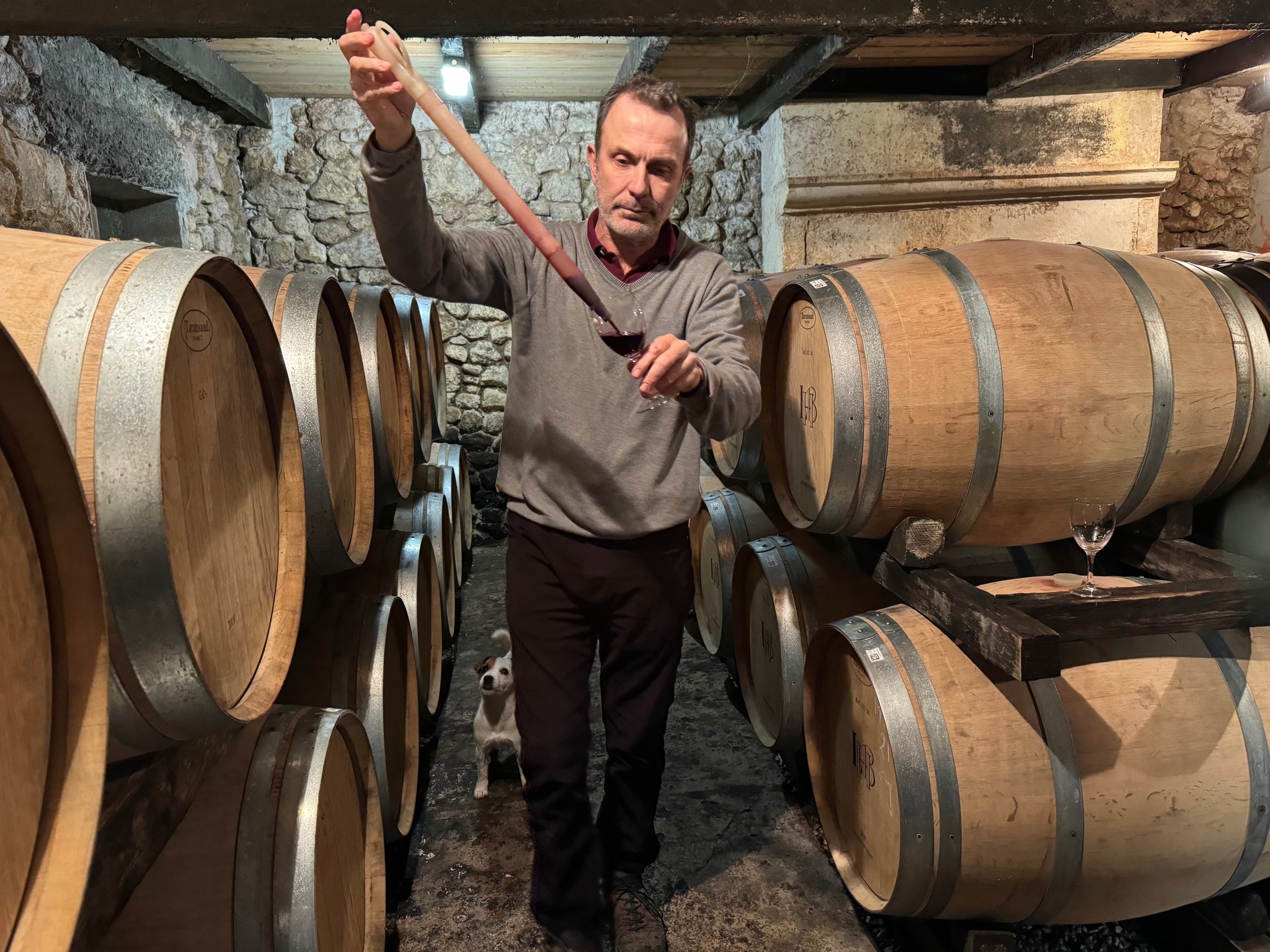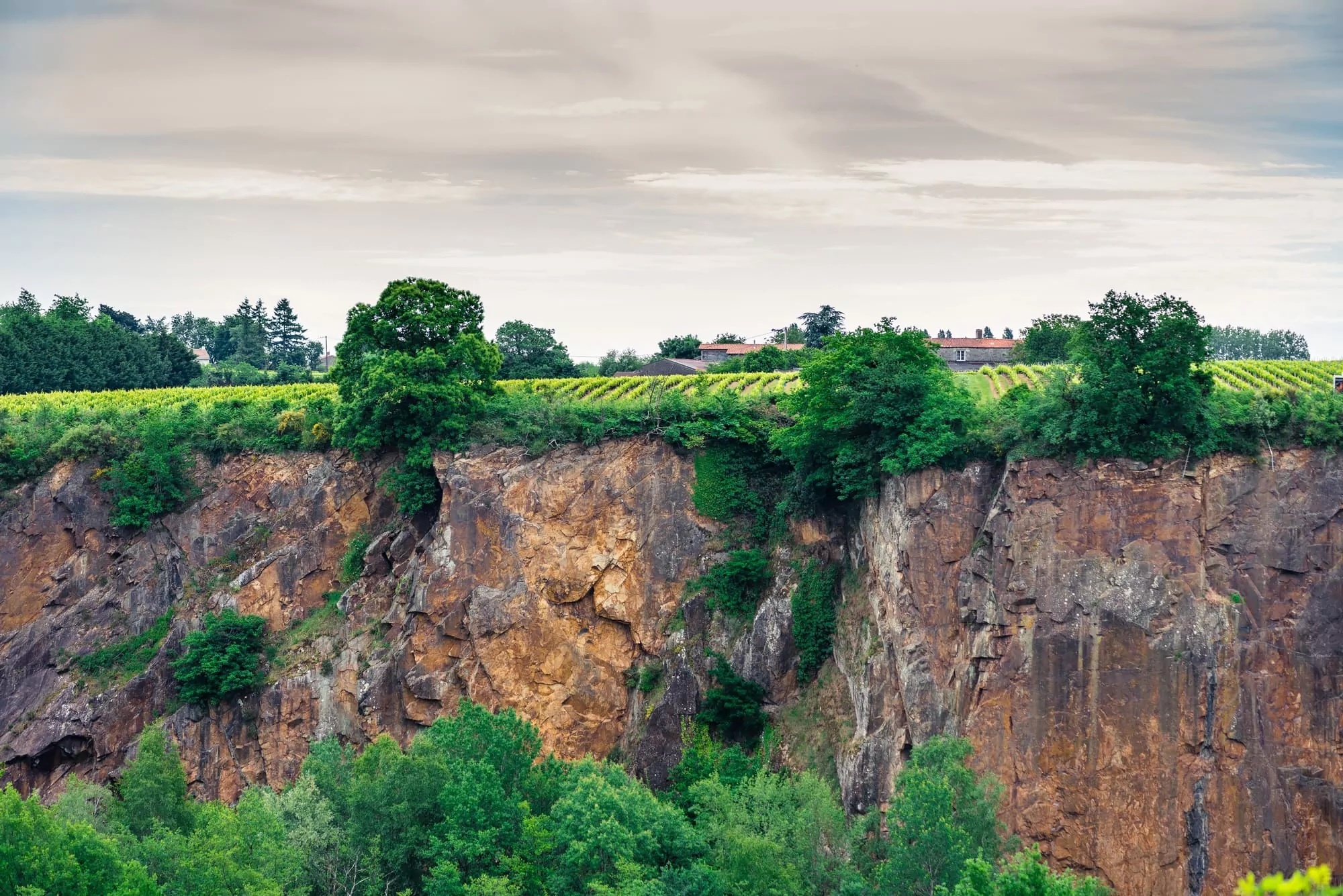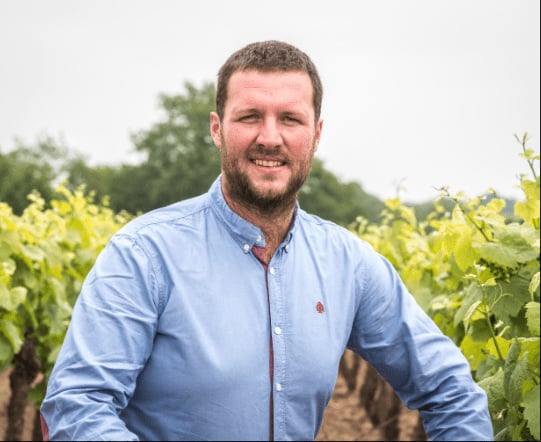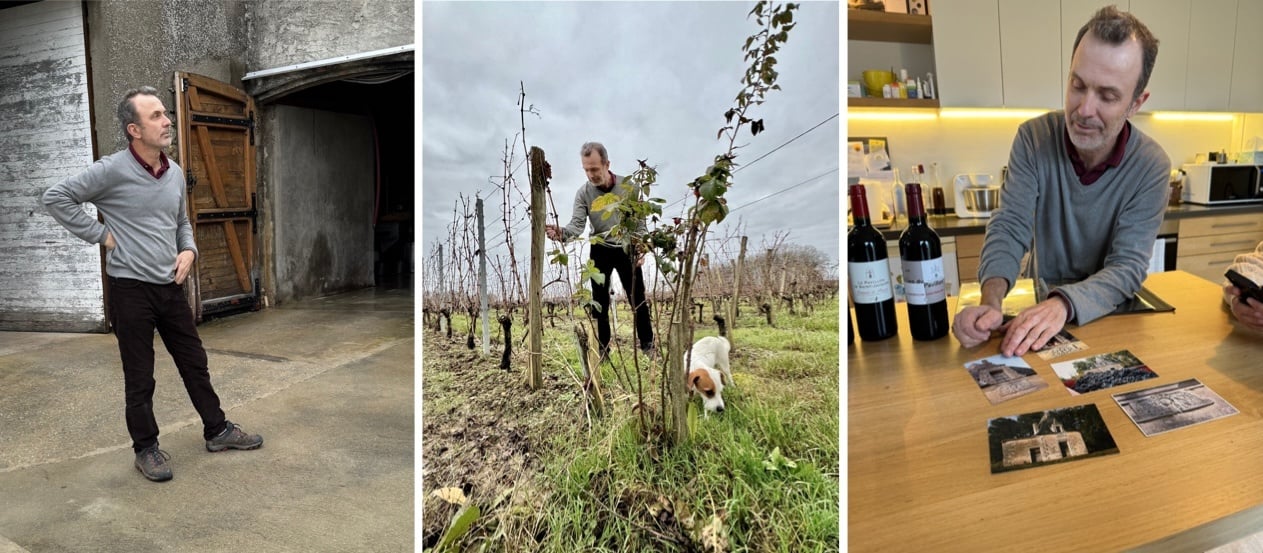
pictured above: Barrel sampling with Gonzague Maurice and Truffle
Antoine et Philippe Delaunay Sud-Est Chateau-Thébaud Muscadet Sévre-et-Maine 2015 $32.99
Delaunay notes provided by Irene Lozach.
My father-in-law was from Bretagne (aka, Brittany). So were his parents, grandparents, and all of their grandparents all the way back. So I’ve spent a lot of time driving around Bretagne, seeking the many incredible sites while being kept company by Radio Montagne Noire playing selections from the last decade's pop hits of the US, North Africa, and ‘continental’ France. I always wondered, when listening to the Radio Montagne Noire station ID, where the hell the Montagne was. And now I know. I was on the Massif Armoricain (namesake to ArmorLux Pull Marin sweaters), what remains of the giant Hercynian range of mountains from the Precambrian era. Today it is hard to believe that mountains once towered above these gentle slopes. But 600 million years of weathering have resulted in dark soils of enormous complexity including gneiss, granite, gabbro, amphibolite, mica schist, and many others. This formation extends from the western Bretagne province of Finister through the Pays Nantais at the eastern border of Brittany and beyond to Anjou where it gives way to the Paris Basin that defines the Central Loire.

Chateau Thébaud cliffs
Here is where the Loire-Atlantique AOCs of Muscadet, Muscadet Sèvre-et-Maine, and that AOCs Crus Communaux are found. These vineyards are nearly exclusively planted to the Melon grape variety (aka, Gamay Blanc, Melon de Bourgogne, Muscadet) which is a sibling variety of Chardonnay and shares that grape's neutral flavor characteristics. Melon is mildew resistant making it well suited to the Loire-Atlantique of Pays Nantais, and in all but the earliest springs is adept at resisting frost. (Recent climate changes have, unfortunately, led to several such early springs and the damage in Muscadet has been intense. Early warm temperatures encourage early budding which presents a risk of frost damage and crop loss should temperatures dip post bud break. This was the case in 2021 when 80% of the crop was lost following 11 nights of sub-zero temps in April.)
Quick Muscadet hierarchy and interactive map
• AOC Muscadet: encompasses the entire region, allows yields up to 70 hl/ha, can make no claims to sur-lie aging unless yields are restricted to 55 hl/ha. Permitted to use Melon on label. Can include up to 10% Chardonnay in blend.
• AOC Muscadet Sèvre-et-Maine: 70% of Muscadet plantings concentrated in an area south of the city of Nantes. Yields are limited to 55 hl/ha. Sur-Lie indication is permitted at these yields adhering to rules that the wine must spend no more than one winter on lees and may not be bottled before March 1 of the year following fermentation, which is between 5 and 14 months of aging on the lees.
• Muscadet Crus Communaux: there are 10 of these. Similar to the cru of Beaujolais these are generally named for one or so nearby villages. Unlike Beaujolais, Muscadet Crus are delineated scientifically by soil type and micro climates. The rules governing production include even lower yields of 45 hl/ha, vines must be six years of age before use, higher ripeness levels must be achieved. The crus Goulaine and Le Pallet must stay on lees until April 1 of the second year following harvest; the other approved crus must age for at least an additional six months, until October 1 of the second year after harvest.
• The Crus Communaux of Muscadet are Clisson, Gorges, La Pallet, Goulaine, Cháteau-Thébaut, Mouzillon Tilléres, Monnierés Saint Fiacres, La Haye Fouasiére, Vallet, Champtoceaux.
Our Muscadet selection this month is from the Cru of Cháteau-Thébaut. Delaunay Vignerons is led by Antoine Delaunay, the 4th generation of the Delaunay family farming their estate in Vertou. Antoine joined his father, Phillippe, in 2016 and only recently took the reins. Phillippe had inherited the 10.5 ha estate from his father in 1983 and has since expanded their holdings to 22 organically farmed hectares of Melon in Muscadet Sèvre-et-Maine.

Antoine Delaunay
A small though important piece of the family holdings lies in the Cru Communaux of Cháteau-Thébaut where the defining soil composition is granodiorite known as Cháteau-Thébaut granite. Its grainy texture is similar to granite though of a darker hue.
The Delaunay approach to lees aging is to exceed by at least a year, and in this case 24 months, the minimum 24 months aging requirement of the cru designation. As is the norm in Muscadet, below ground, glass-lined fermentation and aging tanks are used as they provide effective temperature control and protection from oxygen. Post-fermentation, the dead yeast cells, called lees, are stirred frequently in a process the French call battonage. This circulation encourages full integration of lees character and an oxygen protection effect from the lees early and throughout the lees aging process. Similar to the lees effect on the wine aging in Champagne, significant character is added to Muscadet via lees aging in the impression of cream and yeast aromatics, a full and textural mouthfeel, and the ability for the wines to age beautifully for several years post release.
This Antoine et Phillippe Delaunay Sud-Est 2015 Cháteau-Thébaut is still very youthful at nine years post harvest. Its color is a pristine pale gold with flecks of green. The nose shows pronounced citrus, fennel and flint aromatics with a hint of clean earth and crushed oyster shells. On the palate it has a structural balance of acidity, creamy texture, and alcohol necessary to carry it across several years of bottle aging. Its flavors reflect the aromatics and that trademark Cháteau-Thébaud salinity offers a touch of salted caramel on the long, generous, citrusy finish. Frankly, I keep thinking ‘this is what I love about Chablis’. I guess that’s why the Crus Communaux of Muscadet (and in general the wines of Muscadet) are considered some of the best buys in wine today. Pair with mussels in fennel-saffron broth, or when tomatoes are in season, with tuna, tomato, and basil tartare.

Gonzague Maurice “Victor” Castillon Cotes de Bordeaux 2018 $19.99
Area: 2.20 ha • AOC Castillon Cotes de Bordeaux • Location: on the Gardegan and Belvès de Castillon plateau, 5 km from Saint-Emilion • Soil: Clay-limestone, identical to the best terroirs of Saint-Émilion and Montagne • Vines: 20 years • Planting density: 5500 plants/ha • Grape varieties: 100% Merlot • Farming Practices: Organic*
~notes and photos provided by Andrea~
Gonzague Maurice began his wine career in Sancerre at the cooperative Cave de Sancerre before heading to Bordeaux, where he worked for four years at Château Maucamps in Haut-Médoc, followed by more specialized apprenticeships at the Chevalier estate in Pessac-Léognan, at Château Poupille in Côtes de Castillon, and at Domaine De l'Ile Margaux.

Gonzague Maurice in front of his cellar, in his vines, and showing a photo album (real prints!) of the property, including the little La Folie.
In 2005 he purchased his winery on Bordeaux’s Right Bank, in Montagne, a satellite appellation of St-Émilion, along with 3.2 hectares of vines. The vines were in poor condition and more than 3,000 had to be replanted. The winery was also in rough shape, with all of the concrete tanks having to be thoroughly cleaned and descaled. It was a labor-intensive process immediately followed by taking on another 3.3 hectares of vines on an ideal limestone plateau in nearby Puisseguin.
Gonzague Maurice’s main property, Chateau du Grandchamp, is located on the pilgrimage route to Santiago de Compostela; the estate has a tiny 18th century stone building called “La Folie” which served as a relay point for pilgrims, but also, and probably more frequently, as a naughty rendezvous point for male nobility of the neighboring castle. Gonzague was more than happy to show us photos of this miniature chateau. We inquired if he was willing to sell it, and while his ears appeared to perk up, we have yet to hear back.
Click here for wine map of Bordeaux.
The difference between St-Émilion and Castillon are subtle as far as soils is concerned, but glaring when it comes to land value.
From a 2014 article on www.winedoctor.com (subscription only): …Here, in the northern section of the St Émilion appellation, there is a gentle slope down towards the Barbanne, not the slightly more impressive scarp that there is on the other side of the limestone plateau. The superficial limestones give way to the Molasses du Fronsadais, a soft conglomerate of sedimentary rocks, marl and clay; where we stood, however, the superficial soils were quite sandy. Jean-Luc-Thunevin positioned himself next to the vines to the west. “Here I am in St Émilion”, he announced, going on to suggest that the land was valued at something in the order of about €2million per hectare (for grand cru classé vineyards, not generic St Émilion). Taking a few steps east, into the next vineyard, he continued “and now I am in Castillon”, the land value here said by Jean-Luc to be more like €20,000 per hectare.
The vineyards of Castillon, perhaps more correctly and completely described as Castillon Côtes de Bordeaux, extend eastwards from those of St Émilion; thus there are in fact countless examples of where one famous St Emilion vineyard ends, and another one – classified as Castillon begins. …the focus of the vineyards of Castillon is, just as it is with St Émilion, is the limestone plateau. This plateau extends eastwards, behind Sainte-Colombe, beneath Belvès-de-Castillon, behind Castillon-la-Bataille and out of Bordeaux altogether. It also snakes northwards, alongside the Barbanne, and the same limestone also sits over the river, beneath the St Emilion satellites. The plateau is perhaps not so broad in places as it is in the St Emilion heartland, being cut through by streams and rivers, but its presence is undeniable, and indeed there is much more limestone plateau outside the appellation of St Emilion (here in Castillon, but also in the St Émilion satellites) than there is within St Émilion. Around the plateau are the limestone and clay slopes, degraded limestone tumbling down to the plain below, as well as the aforementioned molasses. The plateau and the côtes are the most desirable spots.
In addition to the above-mentioned info, the vineyards of Castillon are literally in a good position as temperatures rise, since the slopes face east/west as opposed to the (until now) most sought after south-facing slopes of St Émilion.

Up until recently Gonzague’s vines were certified organic, but he let that slip when external pressures (mostly climate related) became too extreme and expensive. So while he still eschews chemicals, he, like many producers in Bordeaux (and France as a whole), is not in a financial position to keep paying for the certification, or to lose an entire harvest that could otherwise be saved with measures that don’t fall under the “organic” umbrella. Not necessarily an organic vs non-organic issue, but while visiting recently, Gonzague told us about how the frequent and destructive post-bud-set frost leads to producers renting helicopters on a moment’s notice at upwards of $2,000 per hour so they can hover over vineyards and push warmer air back down onto the vines. Small producers compete for helicopters with multinational conglomerates (who are buying up properties because French law makes it difficult for children to purchase from their parents), all just waiting for the temps to drop. Then of course small producers get outbid…and so they are the ones who suffer most; kind of a problem not just in wine, and certainly not just in France. So, the fact that we can drink $20 bottles of small-production, thoughtfully produced Bordeaux at this level is a gift.
All that being said, the vines are all worked by hand, with every other row plowed or grassed––no weedkillers. Harvest is by hand as well, with sorting in the vineyard and the cellar. As the winemaker says: “all work is then carried out by hand with the sole objective of obtaining perfectly ripe and healthy grapes (stemming, splitting, leaf stripping, green harvest if necessary).”

Gonzague says this about the 2018 vintage and fermentation: “2018 was marked by a hot and humid spring and early summer, very conducive to the development of mildew!…the harvest was therefore a little smaller than usual, but still at an acceptable level (40 hl /ha, or 12,000 bottles in total)… The rest of the summer was hot and dry; the harvest was beautiful in the end, with very ripe and healthy grapes! The vinifications went well, the aging in concrete vats lasted almost 2 years, the bottling took place at the beginning of September 2020… Above all, I seek to preserve the fruit both during vinification and during aging (no “wood” in this wine, only Merlot!)”
Gonzague gets a mention in Jon Bonne’s lates book, The New French Wine, Redefining the World’s Greatest Wine Culture, in which Bonné states that Victor sees old wood, but alas, according to the winemaker himself, it does not. We all make mistakes!

And here is Jancis Robinson’s review of the 2018 vintage: A year of extremes with a very wet winter and spring, very damaging hail in some areas, severe downy mildew threats in most. A very hot, and dry, summer and autumn allowed winegrowers to decide on their own harvest dates. Powerful, deep-coloured wines with no shortage of (generally well-managed) tannins suggest this may be one of the region’s longer-lived vintages.
Victor is a full-bodied, structured, chewy Merlot. On the nose there is a strong mineral note that suggests stone dust and clay, followed by bright cassis and flowers. On the palate it’s fine-grained, muscular, and elegant, with cassis again, as well as blackberry, anise, and fresh raspberries. These notes wrap around and wind through dusty earth, cocoa powder, black pepper, hints of green pepper, as well as rosemary and thyme. There’s a lot going on in this sturdy little wine. It would benefit from decanting. Pair it with lamb, duck, aged cheddar, lentil and mushroom stew…
We had lunch in St Émilion, at a little place called Chai Pascal. It felt like home, and it felt like missing home...

Curious about what's in this month's Wine Club Four Pack? It's these same two, plus two others. Click here for a peek.
